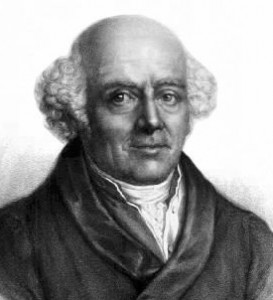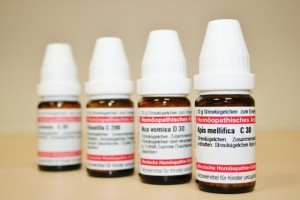What is Homeopathy?
Homoeopathy
„Nunc vos pot entes omnes herbas deprecor, exoro vos maiestatemque vestram, quas parens tellus generavit et cunctis gentibus dono dedit medicinam sanitatis.“
entes omnes herbas deprecor, exoro vos maiestatemque vestram, quas parens tellus generavit et cunctis gentibus dono dedit medicinam sanitatis.“
„Now I appeal to you, you powerful herbs, and I invoke your royal Majesty, because you were made of Mother Earth and given to all people as a gift and medicine for healing.“
(Invocation of the rhizotome in the antiquity, before they went on to labour)
Homeopathy is a system for the treatment of all illness and a wider consideration of how the individual is as a person. Dr. Samuel Hahnemann, a german doctor, discovered the principle behind homoepathy in the late 18th century.
Samuel Hahnemann, the founder of homeopathy, was a Renaissance genius who was skilled in many fields: he was a master pharmacist, a skilled linguist and translater who was fluent in seven languages, and the forerunner of today’s natural healers who promote a natural diet and healthy lifestyle. He could also be called the first psychiatrist, because he was the first person in modern times to promote the humane treatment of the mentally ill as well as curing them with his remedies. Decades before Koch and Pasteur, he understood the principles of contagious illnesses and successfully treated the deadly epidemics which ravaged Europe in the first half of the nineteenth century. Hahnemann could even be considered a pioneer of modern public health and sanitation measures.
Homoeopathy was first established in England in the year 1832 when Dr. Harvey Quin, a friend of Hahnemann, and called by Rochard Haehl ‘Hahnemann’s chief successor’, set up a practice in London. He developed a very successful homoeopathic practice and became very popular in the social circles of his day. Through him Homoeopathy became a popular talking point, so much so that when a book was published by Dr. W. Henderson, Prof. Of Pathology at Edinburgh University, defending Homoeopathy against a detractor, the first edition was sold out within three months.
The nineteenth century produced many other notable homoeopathic physicians, among them Dr. W. Henderson who instituted clinical tests of homoeopathic theories at the Edinburgh Royal Infirmary, Dr. J.H. Clarke and Dr. J. Compton Burnett, both eminent physicians and writers on Homoeopathy, and Dr. Richard Hughes, whose work is commemorated by the „Richard Hughes Memorial Lectures“ held each year at the Royal London Homoeopathic Hospital.
We don’t have to search far in the historical record to find examples of the effective use of homeoprophylaxis.
In 1799 – 3 years after the „birth“ of homoeopathy in Hahnemann’s landmark article Essay on a New Principle – Samuel Hahnemann achieved fame throughout Europe from his exceptionally effective treatment of a Scarlatina epidemic that was sweeping Germany. He wrote:
„I resolved in this case of scarlet fever just in the act of breaking out, not to act as usual in reference to individual symptoms, but if possible (in accordance with my new synthetical principle) to obtain a remedy whose peculiar mode of action was calculated to produce in the healthy body most of the morbid symptoms which I observed combined in this disease.
My memory and my written collection of the peculiar effects of some medicines, furnished me with no remedy so capable of producing a counterpart of the symptoms here present, as Belladonna.“
 What is Homeopathy?
What is Homeopathy?
Homeopathy is a complementary or alternative medicine (CAM). This means that homeopathy is different in important ways from treatments that are part of conventional western medicine.
A central principle of the ‚treatment‘ is that ‚like cures like‘ – that a substance that causes certain symptoms can also help to remove those symptoms. A second central principle is based around a process of dilution and shaking, called succussion.
Homeopathy is used to ‚treat‘ an extremely wide range of conditions, including physical conditions such as asthma and psychological conditions such as depression.
The progress of Homoeopathy
S. Hahnemann use plants and herbs but also many other substances to induce symptomes, woth the aim of using as cures for diseases where the symptomes were similar.
In the process of this, he used many materials that were potentially toxic. So he investigated using dilute solutions of these materials. So he found that the diluted substances retained the ability to cause symptoms, therefore making them safe to use.
Three approaches for homoeoprophylaxis
Three approaches may be used to select the remedy for prophylaxis of a prevailing epidemic. All have their roots in classical practice, but it is the selection of a genus epidemicus – an individually selected remedy for this particular outbreak of an epidemic – which is to be sought as the surest and most closely aligned with our guiding principles. Initially though, allow me to describe two other approaches, which may prove of use in particular circumstances.
The first of these is the use of the disease nosode in prophylaxis. Examples would be the use of Influenzinum in flu prophylaxis or Morbillinum in a measles epidemic. Closely related to this would be the use of the sarcode Anas barbare hepatis et cardus extractum (liver and heart of the Barbary duck) for ‚flu. Derived from tissues of the native host of influenza, this remedy is prepared from tissue containing and reacting to the influenza virus.
The nosode represents the undifferentiated or generic appearance of an acute miasm, not accounting for individual variability of persons or individual epidemic occurrences. Its routine use in active disease would be considered isopathy rather than homoeopathy; and historical experience reveals the general inadequacy of this approach.
However, in prophylaxis, this may be a successful strategy in a pinch, particularly early in the epidemic of an acute miasmatic illness, before a genus epidemicus – the specific remedy for the individual epidemic – has been identified. Following Hering’s introduction of nosodes into our Materia Medica, Boenninghausen experimented early on, with considerable success, at using Variolinum (the smallpox nosode) for the prophylactic treatment of smallpox.
The second approach is to select a remedy deemed central to the undifferentiated or generic nature of the epidemic illness. This is done by taking an anamnesis of the disease-as-named, without specific attention to the individuality of the prevailing epidemic or the individuality of a specific case. Examples might include Drosera for whooping cough or Eupatorium perfoliatum for influenza.
Here again the individual nature of the particular epidemic is not taken into account, and this approach works best with those epidemic illnesses that can be termed acute miasms – ones in which there is less variability in individual expression. Hahnemann in this manner suggested Camphora as the homoeoprophylactic simillimum for the approaching epidemic of Asiatic Cholera. Boenninghausen had some excellent success in using Thuja occidentalis in this manner in the prophylactic treatment of smallpox.
This of course can only be done for those diseases that Hahnemann would class as „acute miasms“ – diseases that „recur in the same manner and are therefore known by a traditional name“. As an example, we could look at Scarlatina (scarlet fever), much as Hahnemann himself did in 1799 in Königslutter.he approaching epidemic of Asiatic Cholera. Boenninghausen had some excellent success in using Thuja occidentalis in this manner in the prophylactic treatment of smallpox.
Homeopathy by acute and chronic diseases:
Again:
Homeopathy is used for an extremely wide range of health conditions. Homeopathy can help with any condition.
The most common conditions that a homeopathic treatment can help:
- asthma
- ear infections
- hay fever
- mental health conditions, such as depression, stress and anxiety
- allergies, such as food allergies
- dermatitis (an allergic skin condition)
- arthritis
- high blood pressure
- rheumatisme
…and so on.
And accompanying by following diseases for example:
- cancer
- multiple sclerosis
…and so on.
Résumé
Homeopathy is really not a „pill for every ill“. But moreover it can offer a safe alternative to conventional medical treatments, and it can usually be given alongside ordinary medicines without causing problems, if it needs.
Your Susan Fischer
